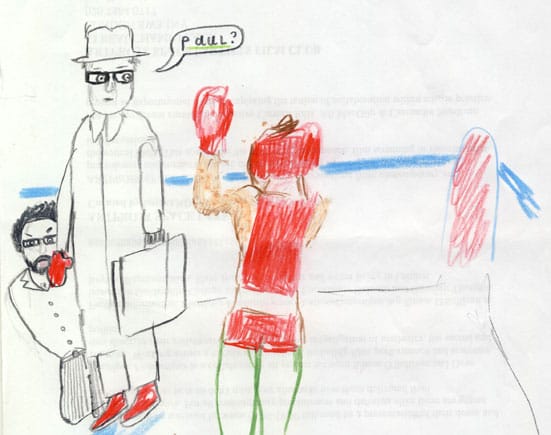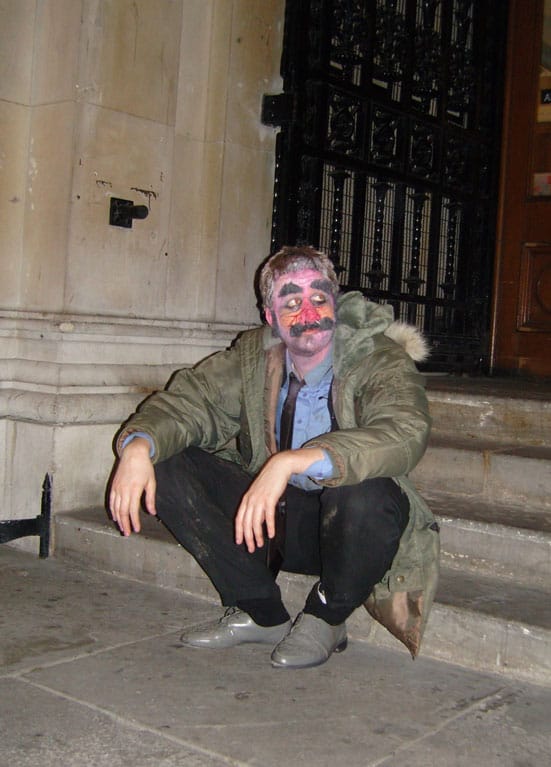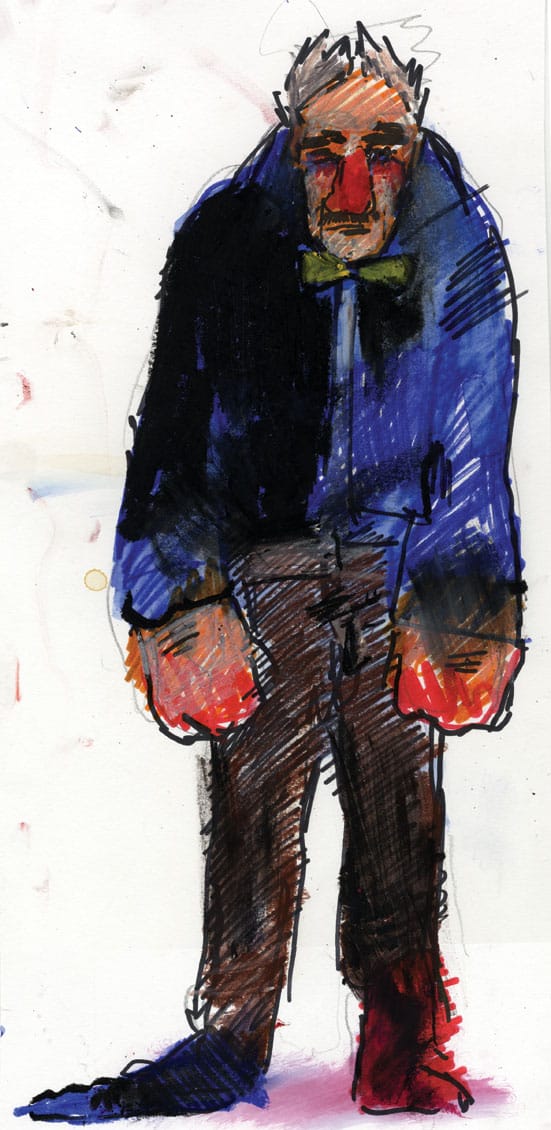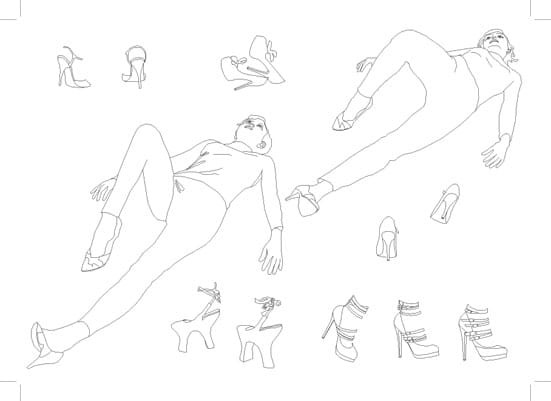The artists boyleANDshaw (Adrian Shaw and Matt Boyle), Adam James and Malin Ståhl, collaborated together on an ambitious performance work ‘Dynamite Fighter’ which took place as part of GSK Contemporary at the Royal Academy on 27 November 2008.
boyleANDshaw:
AM: How did you first become interested in the character of Paul Sykes, who has figured in your recent performances at GSK Contemporary at the Royal Academy and at 176.? How has this former boxer who became homeless and was awarded the first ASBO in Wakefield come to inform your practice so strongly?
AS:
Puaul is well know where we we brought up
Leeds Barnsley
He started making the local news a few years back as his stories made good copy
Pissing in bob the builder machines
A fallen hero etc
Hes now dead
But his position against life we were drawn to
His walking away refusal to engage with rules
Walking his own way
His energy is begling
a-everything
amoral
We were drawn to it very natuarlly and saw some move that is endlessly creating
And unfathamable
Like some force but working
For us we distalled what we could
And what we can
Paul as wind
maybe
Deleuzian move on haecceity
D&G explain, is a mode of individuation very different from a person, a subject, a thing, or a substance. A haecceity might refer rather to a season, a time of day, a wind.
And were endlessly trying to catch the wind Donavan style
888888888
MB:
he's always been in us. all us.
specifically: school yards. sporting temperament. fighting before trip to center parks, 1989. this thundering vile pirouette. team banging and parading versus us singles conjoined, violently clobbering. pitbulls. white rose centre. the ritz- merrion centre. well-dun bacon butties and ice ice cold milk from a silver hot-water tank. dancing and fighting. one's revolving, twisted mel'ee of shit and piss and grit and spit and abusive wit. he existed. he is our dad figure. who found a name for discussing but ceases to beat us. exist. totally.
AM: Did your recent performance, Dynamite Fighter, at the R.A. develop beyond your original proposal, and in what ways? You took your inspiration from a wide variety of sources, a documentary on Paul Sykes, Keppler's law, Stanley Kubrick's film version of Clockwork Orange, Allen Jones's unrealised designs for the Korova Milkbar from his book ‘Allen Jones Projects’ 1971. You also invited the collaboration of the band Lark, and four performance artists, Adam James, Jennie Fagerström, Malin Ståhl and Anita Wernström. How did these elements synthesise in your thinking?
AS:
Again we were improvising
Were interested in the paradox of creativity needing boundaries
What elements are necessary to make something work
To improvise jam
How to build something that stands up
To give birth to something that is not us
Where we are not the authers
Were just catalysts
Etc hazzording an inmprovisation
After deleuze
What eelemnts do you need to set something spinning
How do you work with peeple to allow them to work freely with you but still keeping the energy of a thought/ideas that first gripped us
We were freely improsing with the various ellemnets
Twe had no real direction until the rehersals and work openly enough to allow movement and exchange but at some point draw some boundaries but always drawn To be obliterated
Not in sequence but always at the same time
See Deleuze and guattaris refrian plataux
MB:
it happened initially in a dream we both had at different times. we often have exactly the same dream. via internal (identical) electrodes that judder (repeatedly), we are epileptic in memory and action.
the source material was visited, collected, suggested, stuck, ran, and swam off before returning and becoming purposefully disfigured and re-modeled and re-mapped and re-plotted: the palette.
team bAs: all gold. all random in inclusion, bolstered by wandering around. the collating of a group was new to any work previous. it added meat to bones and made the soup taste better than mi mums. individually all had input and output, it showed in a performance that pulled and tugged on your viewing capabilities, capacity. like brecht, the audience of watchers charged an environment that already lived, breathed and sweated in secret. secret society that flourished and killed and recycled. and more.
AM: Do you see the process of collaboration as integral to your practice?
AS:
Yep, for us, there is cannot be an 'I'
There is no other way to work for us
Were only interested in multiplication, growth spurts, an organic mess of blues
For the sake of growing it
Sometime s its pretty sometimes its good to blow holes in doorsbut never any purpose
No purpose just sound John Cage I think
MB:
yep (agree). our only way to make, move.
AM: Alongside your artistic practice, you curate monthly events at Artprojx space. Do the parallel activities of art-making and curating tie together productively for you?
AS:
For us is all part of the same move
Inscribedwith the same move
Although were endlessly trying to find the s move get on itas it were
MB:
same same. fact the move is a greater productive output,
no finish is ever needed. a start rarely comes. and the middle is for eating at john's. john owns a caf.
best philanthropist we know. great team player.
AM: How long have you two been working as a duo? How did you meet? What are the advantages and disadvantages of working together?
AS:
2 years in jan we did our first performance
8888888888
AM: What do boyleANDshaw have in the pipeline for 2009?
AS:
Another performance at the 176 on the 17 jan
A piece called the Funnel of Love
This work came from our interest in funnels. Trumpets as funnels, drinking games using funnels, songs about falling into love funnels, gravity wells as funnels, 'coin orbiters' as funnels and the connection with Kepler's Second Law. Our aim as ever is 'to find the conditions under which something new is produced' (Deleuze). This work is a 'groping experiment' to try and produce an environment that is open ended with multiple entry and exit points. A creative and fluid environment where components multiply with each other to in new and unusual ways.
A film called
The land of dreams in a grouop dshow the LCC in Feb
The Land of Dreams
This short film by boyleANDshaw takes as its starting point an imaginary moment where ex-footballer Paul 'Gazza' Gascoigne sits beneath an oak tree in Kew Gardens. The oak tree in question was planted from an acorn brought back by a solider from the WW1 battlefields in Verdun. Gascoigne, one of the most gifted footballers of his generation, now struggling with drugs and alcohol addiction, appeared in the press after a visit to Kew in June 2008 with his ex-wife. In this film boyleANDshaw improvise around a single hallucinatory moment in which the semi-fictionalised character of 'Gazza' tenderly embraces his wife in the shade of the tree, under the symbolic shadow of the trees tragic history.
The Title is taken form a chapter in Enid Blyton's The Magic Faraway Tree. This series of surreal and fantastical stories revolve around an enchanted wood where a gigantic magical tree, the "Faraway Tree", grows. At the top of the tree is a ladder which leads to a magic land, visitors are free to come and go, but they have to leave before the land "moves on" or else they're left stranded forever.
More stuuf at Artprojx Space
Were doing some salon projects
Called
boyleANDshaw Art Salon Projects
Next one on the 22 Jan, films DJs etc
boyleANDshaw Art Salon Projects 2
The second in a series of nights curated by boyleANDshaw to promote the work of emerging contemporary art practitioners . Expect a vibrant mix of film, performance, talks and music.
Supported by Awards For All
MB:
yep, growth in boyle family tree. im on catch up.
domestic liberation!!!
Adam James
AM: Could you tell me about your recent work and your residency in Paris?
AJ: Recently I have been transforming myself into a range of fictionalised characters, as a method to flip my own real-life encounters for the audience. The subject for these appropriated characters has most recently been tramps and peripheral archetypes existing in-between the cracks of society. I spent my last summer in France at Cite des Arts Internationale, studying Parisian tramps, in search of characters which were aberrations, or fractures of the norm. For me the Parisian tramp is a wonderfully outrageous, smelly and cantankerous embodiment of the modern day Witch. I studied, and then transformed myself into these tramps and made a series of short films in the amazing Park, La Buttes Chamount. The end results look a bit like a strange hybrid of Cindy Sherman, Bruce Nauman and Buster Keating.
AM: In light of your recent work, the role of Paul Sykes in Dynamite Fighter seems made for you! How did you prepare for the role? What was the experience of spending 4 hours in his skin like?
AJ: Preparation for the role of Sykes involved watching and absorbing as much as I could from a documentary on his life. Paul was a genius; he said so many great things that I was spoilt for material. The costume was an amalgamation of Paul through the years; I wanted to reference a moment in the documentary where Paul was hosting a charity auction and dressed in a tuxedo. I liked the idea of him clinging onto that, even though he ended up living on the streets, reeking of alcohol. For the costume, there was much trawling of charity shops and dousing of clothes in gin, special brew, vodka, fish sauce, vinegar, mayonnaise, mud and jam. I had not planned to drink during the performance, but by the end I was pretty plastered on bitter. Besides, who wouldn’t want to get drunk and stagger about the Royal Academy, hurling abuse and getting your dick out (all be it a false one)? My father was himself a schizophrenic, heroin addict and alcoholic. I have grown up never having met him, and following the recent discovery of his death this performance, allowed me some insight and understanding of his tragic life.
AM: Do you enjoy the process of collaboration?
AJ: Yes very much! For me collaboration is a machine for generating happy accidents. There is an overall plan, everyone has a part to play, as it nears the realisation tension grows which, is released in an explosion of uncertainty and creativity. As a filmmaker, I am often very reliant on others expertise, or simple willingness to lend a hand. Working with Malin, Anita and Jennie was great, especially as we had no idea how we would physically encounter each other during the performance, I was surprised how far they were willing to go when push came to shove! The whole experience felt very fresh and chaotic, it felt like we could have carried on all night!
AM: What projects are you working on at the moment?
AJ: At the moment I am researching London tramps and working towards a series of twilight photos and films of characters on top of man-made mounds around London. I want to explore the notion of delusion and loss of control as being something terrifying yet also beautiful. I am also interested in exploring mental ‘breakdown’, and how it might bring one closer to God, or a deluded sense of Godliness. Another project I am planning is the construction and large biblical tower, a sort of totem of worship built from unwanted clothes, rags and rubbish. I want this to act as focal point for a film in which a group of native, outsider clown like characters burn it to the ground. Finally I am working towards my first solo show, and also my first attempt at co-curating a show here and in Thailand.
Malin Ståhl
AM: Could you tell me about your collaboration with boyleANDshaw in Dynamite Fighter at the R.A.?
MS: After the initial meetings when I think Adrian and Matt sort of watched us and decided how to fit us into the five parameters they had developed for the ‘waitresses’, I started thinking about how the real person inside the ‘waitress’ would think and react within the context of the performance. That is when I linked to feminist self-defence, to keep yourself safe and possess the ability to neutralize a perpetrator. At the same time I also felt that the person inside the ‘waitress’ was protected by the cold, perfected look-but-not-touch appearance of the ‘waitresses’. I think this largely decided the look of our performance, we knew that we were untouchable and we made clear that we could defend ourselves.
Then Adrian and Matt encouraged us to have a secret agenda, and that became the orange kiss. For part of the performance we carried orange quarters on hubcaps, to offer to the audience, occasionally we put an orange quarter in our own mouths, much like a gum shield, and met in a kiss, orange touching orange.
AM: Is the process of collaboration important in your practice?
MS: Collaboration at its best can open up to new expression that neither participator had foreseen. I think I have quite fixed ideas on what I am interested in and not, my work is always a search for something I don’t know or haven’t defined, but I think it is a search within a defined area. This is where collaboration becomes important to me, it becomes an arena where things can evolve outside of my full control and the work becomes less ‘mine’ but something ‘more’.
AM: Are you working on any other projects at the moment?
MS: I’m working on a project with five photographers and my created characters, where the photographers chose four characters each to portray. The photographer has full control of the process of the portrait whereas I retain full control of the character. I’ve also started sketching on a new video, about a pirate in forest.
Ali MacGilp

Drawing by boyleANDshaw ‘Dynamite Fighter’ flyer

Preparatory collage for ‘Dynamite Fighter’ by boyleANDshaw, featuring Allen Jones’s designs for the Korova Milkbar

Photograph from ‘Dynamite Fighter’ performance, Adam James as ‘Paul’

Photograph from ‘Dynamite Fighter’ performance, Jennie Fagerström, Malin Ståhl and Anita Wernström as the ‘Waitresses’

Adam James preparatory drawing for ‘Paul’

Malin Ståhl preparatory drawing for ‘Waitresses’